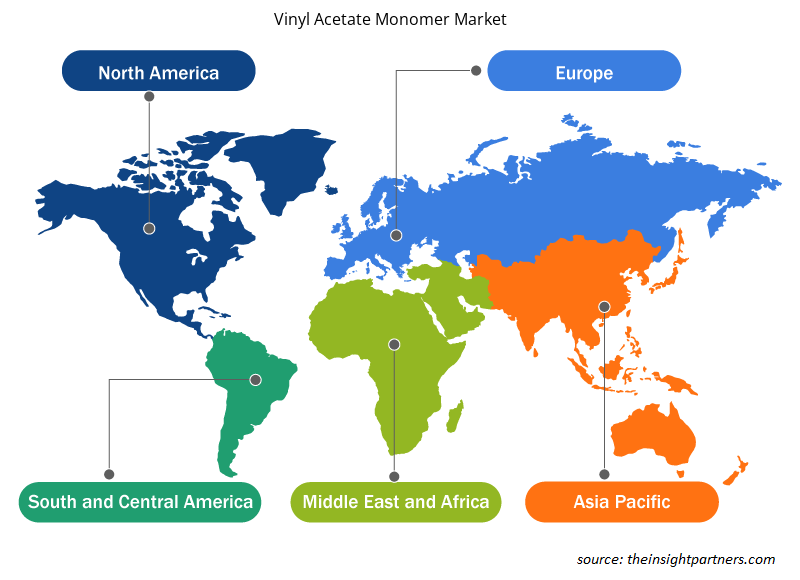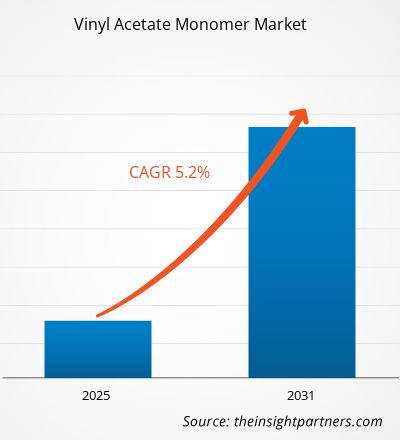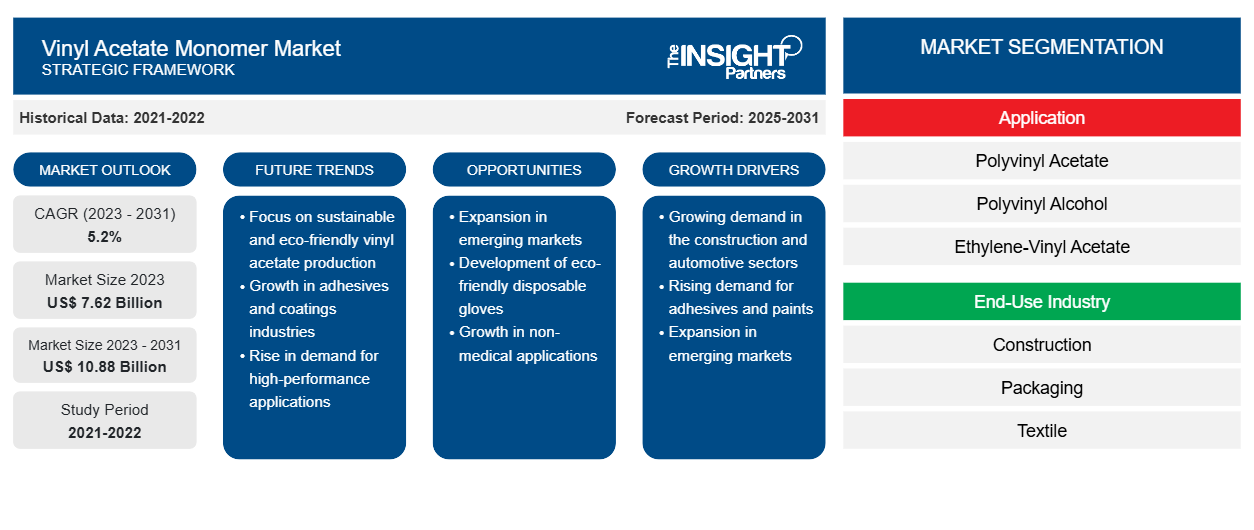Der Markt für Vinylacetatmonomere soll von 7,62 Milliarden US-Dollar im Jahr 2023 auf 10,88 Milliarden US-Dollar im Jahr 2031 anwachsen. Der Markt wird voraussichtlich zwischen 2023 und 2031 eine durchschnittliche jährliche Wachstumsrate von 5,2 % verzeichnen. Die wachsende Nachfrage aus verschiedenen Endverbrauchsbranchen dürfte weiterhin ein wichtiger Trend auf dem Markt für Vinylacetatmonomere bleiben.
Marktanalyse für Vinylacetat-Monomer
Der Markt wird in erster Linie von Faktoren wie der steigenden Nachfrage nach Vinylacetatmonomer aus verschiedenen Endverbrauchsbranchen getrieben. Vinylacetatmonomer (VAM) ist ein wichtiges Zwischenprodukt zur Herstellung einer Reihe von Polymeren und Harzen. Vinylacetatmonomer ist ein wichtiger Rohstoff zur Herstellung von Chemikalien, die dann zur Herstellung einer breiten Palette von Verbraucher- und Industrieprodukten verwendet werden. Polyvinylacetat hat starke Hafteigenschaften für verschiedene Materialien, darunter Papier, Holz, Kunststofffolien und Metalle. Diese Faktoren treiben den globalen Markt für Vinylacetatmonomer weltweit maßgeblich an.
Marktübersicht für Vinylacetat-Monomer
Der Markt für Vinylacetatmonomer ist ein wichtiger Bereich der chemischen Industrie. Vinylacetatmonomer ist ein wichtiger Baustein bei der Synthese verschiedener Polymere und Harze wie Polyvinylacetat (PVA), Polyvinylalkohol (PVOH) und Ethylen-Vinylacetat -Copolymer (EVA). Diese Materialien werden häufig in Bereichen wie Klebstoffen, Farben, Beschichtungen, Textilien und Verpackungen verwendet. Zu den Faktoren, die den weltweiten Markt für Vinylacetatmonomer beeinflussen, gehören wirtschaftliche Expansion, Industrialisierung und technologischer Fortschritt.
Passen Sie diesen Bericht Ihren Anforderungen an
Sie erhalten kostenlos individuelle Anpassungen an jedem Bericht, einschließlich Teilen dieses Berichts oder einer Analyse auf Länderebene, eines Excel-Datenpakets sowie tolle Angebote und Rabatte für Start-ups und Universitäten.
-
Holen Sie sich die wichtigsten Markttrends aus diesem Bericht.Dieses KOSTENLOSE Beispiel umfasst eine Datenanalyse von Markttrends bis hin zu Schätzungen und Prognosen.
Markttreiber und Chancen für Vinylacetat-Monomer
Wachsende Nachfrage aus verschiedenen Endverbrauchsbranchen
Vinylacetatmonomer ist ein wesentlicher Rohstoff bei der Herstellung vieler Polymere und Harze. Vinylacetatmonomer ist der wichtigste Rohstoff für die Herstellung von Polyvinylacetat (PVA), Polyvinylalkohol (PVOH), Ethylenvinylacetat (EVA) usw. Polyvinylacetat hat starke Hafteigenschaften für verschiedene Materialien, darunter Papier, Holz, Kunststofffolien und Metalle. Es ist auch ein wichtiger Bestandteil von Holzleim, Weißleim, Tischlerleim und Schulleim. Polyvinylalkohol wird für selbstklebende Verpackungsfolien verwendet. Die steigende Nachfrage nach Klebstoffen aus verschiedenen Branchen wie dem Baugewerbe, der Möbelindustrie usw. treibt das Marktwachstum voran.
Steigende Auslastung in der Elektronikfertigung
Ethylen-Vinylacetat ist ein thermoplastisches Polymer, das in Solarzellen/-modulen als Verkapselungsmittel verwendet wird. Ethylen-Vinylacetat ist eines der am häufigsten verwendeten Verkapselungsmaterialien für Photovoltaikmodule. Das Photovoltaikmodul mit dieser Art der Verkapselung schützt die Zellen vor mechanischer Beschädigung und Feuchtigkeitseintritt. Verkapselungsfolien spielen eine wichtige Rolle dabei, das Eindringen von Wasser und Schmutz in Solarmodule zu verhindern . Ethylen-Vinylacetat wird zunehmend zur Verkapselung von Solarmodulen verwendet, da es verschiedene für Solarmodule gewünschte Eigenschaften aufweist, wie z. B. einen hohen elektrischen Widerstand, geringe Wasseraufnahme, hervorragende optische Übertragung, gute Klebeeigenschaften, hohe Elastizität usw.
Segmentierungsanalyse des Vinylacetatmonomer-Marktberichts
Das Schlüsselsegment, das zur Ableitung der Marktanalyse für Vinylacetatmonomer beigetragen hat, ist die Qualität.
- Basierend auf der Anwendung ist der Markt für Vinylacetatmonomer in Polyvinylacetat (PVA), Polyvinylalkohol (PVOH), Ethylen-Vinylacetat (EVA) und andere unterteilt. Das Untersegment Polyvinylacetat (PVA) hatte im Jahr 2023 einen größeren Marktanteil.
- Basierend auf der Endverbrauchsbranche ist der Markt für Vinylacetatmonomer in die Bereiche Bau, Verpackung, Textil und Sonstige unterteilt. Das Untersegment Bau hielt im Jahr 2023 einen größeren Marktanteil.
Marktanteilsanalyse für Vinylacetat-Monomer nach geografischer Lage
Der geografische Umfang des Marktberichts für Vinylacetat-Monomer ist hauptsächlich in fünf Regionen unterteilt: Nordamerika, Asien-Pazifik, Europa, Naher Osten und Afrika sowie Südamerika/Süd- und Mittelamerika.
Der asiatisch-pazifische Raum erlebt einen Aufschwung aufgrund der zunehmenden Urbanisierung und des starken Wachstums der Automobil- und Baubranche, was den wichtigsten Marktteilnehmern auf dem Vinylacetatmonomermarkt reichlich Gelegenheiten bietet. Daher wird erwartet, dass der Anstieg der Bautätigkeiten die Expansion des globalen Vinylacetatmonomermarktes in den kommenden Jahren weiter vorantreiben wird.
Regionale Einblicke in den Vinylacetatmonomermarkt
Die regionalen Trends und Faktoren, die den Vinylacetatmonomer-Markt während des Prognosezeitraums beeinflussen, wurden von den Analysten von Insight Partners ausführlich erläutert. In diesem Abschnitt werden auch die Marktsegmente und die Geografie des Vinylacetatmonomers in Nordamerika, Europa, im asiatisch-pazifischen Raum, im Nahen Osten und Afrika sowie in Süd- und Mittelamerika erörtert.

- Erhalten Sie regionale Daten zum Vinylacetatmonomermarkt
Umfang des Marktberichts über Vinylacetatmonomer
| Berichtsattribut | Details |
|---|---|
| Marktgröße im Jahr 2023 | 7,62 Milliarden US-Dollar |
| Marktgröße bis 2031 | 10,88 Milliarden US-Dollar |
| Globale CAGR (2023 - 2031) | 5,2 % |
| Historische Daten | 2021-2022 |
| Prognosezeitraum | 2025–2031 |
| Abgedeckte Segmente |
Nach Anwendung
|
| Abgedeckte Regionen und Länder |
Nordamerika
|
| Marktführer und wichtige Unternehmensprofile |
|
Marktteilnehmerdichte für Vinylacetatmonomer: Auswirkungen auf die Geschäftsdynamik verstehen
Der Markt für Vinylacetatmonomere wächst rasant, angetrieben durch die steigende Endverbrauchernachfrage aufgrund von Faktoren wie sich entwickelnden Verbraucherpräferenzen, technologischen Fortschritten und einem größeren Bewusstsein für die Vorteile des Produkts. Mit steigender Nachfrage erweitern Unternehmen ihr Angebot, entwickeln Innovationen, um die Bedürfnisse der Verbraucher zu erfüllen, und nutzen neue Trends, was das Marktwachstum weiter ankurbelt.
Die Marktteilnehmerdichte bezieht sich auf die Verteilung von Firmen oder Unternehmen, die in einem bestimmten Markt oder einer bestimmten Branche tätig sind. Sie gibt an, wie viele Wettbewerber (Marktteilnehmer) in einem bestimmten Marktraum im Verhältnis zu seiner Größe oder seinem gesamten Marktwert präsent sind.
Die wichtigsten auf dem Markt für Vinylacetat-Monomer tätigen Unternehmen sind:
- Celanese Corporation
- Chang Chun Gruppe
- China Petroleum & Chemical Corporation
- Dairen Chemical Corporation
- Japan VAM & POVAL Co. Ltd
Haftungsausschluss : Die oben aufgeführten Unternehmen sind nicht in einer bestimmten Reihenfolge aufgeführt.

- Überblick über die wichtigsten Akteure auf dem Vinylacetat-Monomer-Markt
Neuigkeiten und aktuelle Entwicklungen zum Vinylacetat-Monomer-Markt
Der Markt für Vinylacetatmonomer wird durch die Erhebung qualitativer und quantitativer Daten nach Primär- und Sekundärforschung bewertet, die wichtige Unternehmensveröffentlichungen, Verbandsdaten und Datenbanken umfasst. Im Folgenden finden Sie eine Liste der Entwicklungen auf dem Markt für Vinylacetatmonomer und Strategien:
- Dairen Chemical beabsichtigt, die VAM-Produktion im Werk Mayliao im März einzustellen. (Quelle: Dairen Chemical, Website, 2024)
- Die Celanese Corporation gab den Abschluss einer Initiative mit extrem geringem Kapitaleinsatz bekannt, bei der bestehende Produktions- und Infrastrukturanlagen umfunktioniert werden, um zusätzliche Ethylenvinylacetat-(EVA-)Kapazitäten an ihrem Standort in Edmonton, Alberta, zu schaffen. Die Entwicklung wird dazu beitragen, das nachgelagerte Vinylangebot der Acetylkette erheblich zu erweitern. (Quelle: Celanese Corporation, News, 2023)
Marktbericht zu Vinylacetat-Monomer – Umfang und Ergebnisse
Der Bericht „Marktgröße und Prognose für Vinylacetat-Monomer (2021–2031)“ bietet eine detaillierte Analyse des Marktes, die die folgenden Bereiche abdeckt:
- Marktgröße und Prognose auf globaler, regionaler und Länderebene für alle wichtigen Marktsegmente, die im Rahmen des Projekts abgedeckt sind
- Marktdynamik wie Treiber, Beschränkungen und wichtige Chancen
- Wichtige Zukunftstrends
- Detaillierte PEST/Porters Five Forces- und SWOT-Analyse
- Globale und regionale Marktanalyse mit wichtigen Markttrends, wichtigen Akteuren, Vorschriften und aktuellen Marktentwicklungen
- Branchenlandschaft und Wettbewerbsanalyse, einschließlich Marktkonzentration, Heatmap-Analyse, prominenten Akteuren und aktuellen Entwicklungen
- Detaillierte Firmenprofile
- Historische Analyse (2 Jahre), Basisjahr, Prognose (7 Jahre) mit CAGR
- PEST- und SWOT-Analyse
- Marktgröße Wert/Volumen – Global, Regional, Land
- Branchen- und Wettbewerbslandschaft
- Excel-Datensatz
Aktuelle Berichte
Erfahrungsberichte
Grund zum Kauf
- Fundierte Entscheidungsfindung
- Marktdynamik verstehen
- Wettbewerbsanalyse
- Kundeneinblicke
- Marktprognosen
- Risikominimierung
- Strategische Planung
- Investitionsbegründung
- Identifizierung neuer Märkte
- Verbesserung von Marketingstrategien
- Steigerung der Betriebseffizienz
- Anpassung an regulatorische Trends























 Kostenlose Probe anfordern für - Markt für Vinylacetatmonomer
Kostenlose Probe anfordern für - Markt für Vinylacetatmonomer